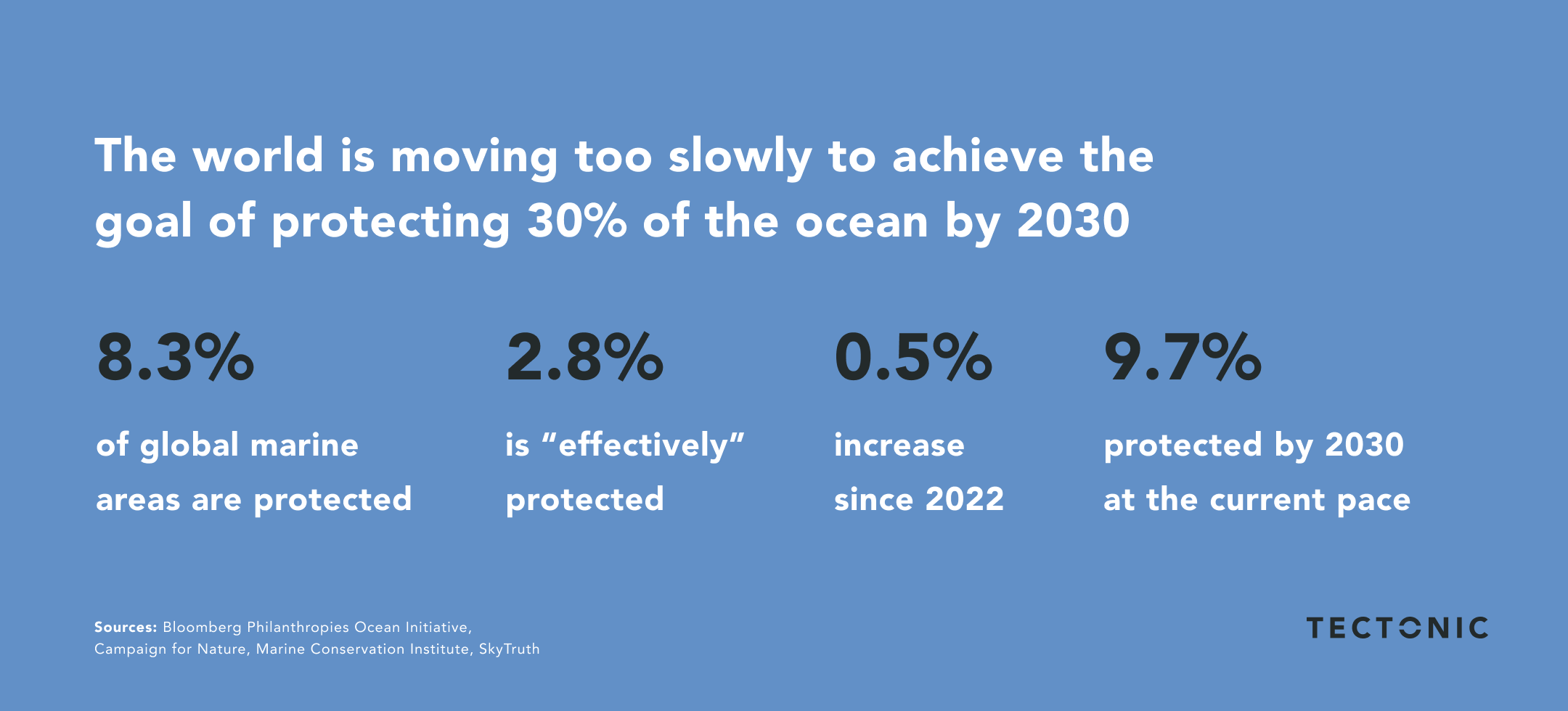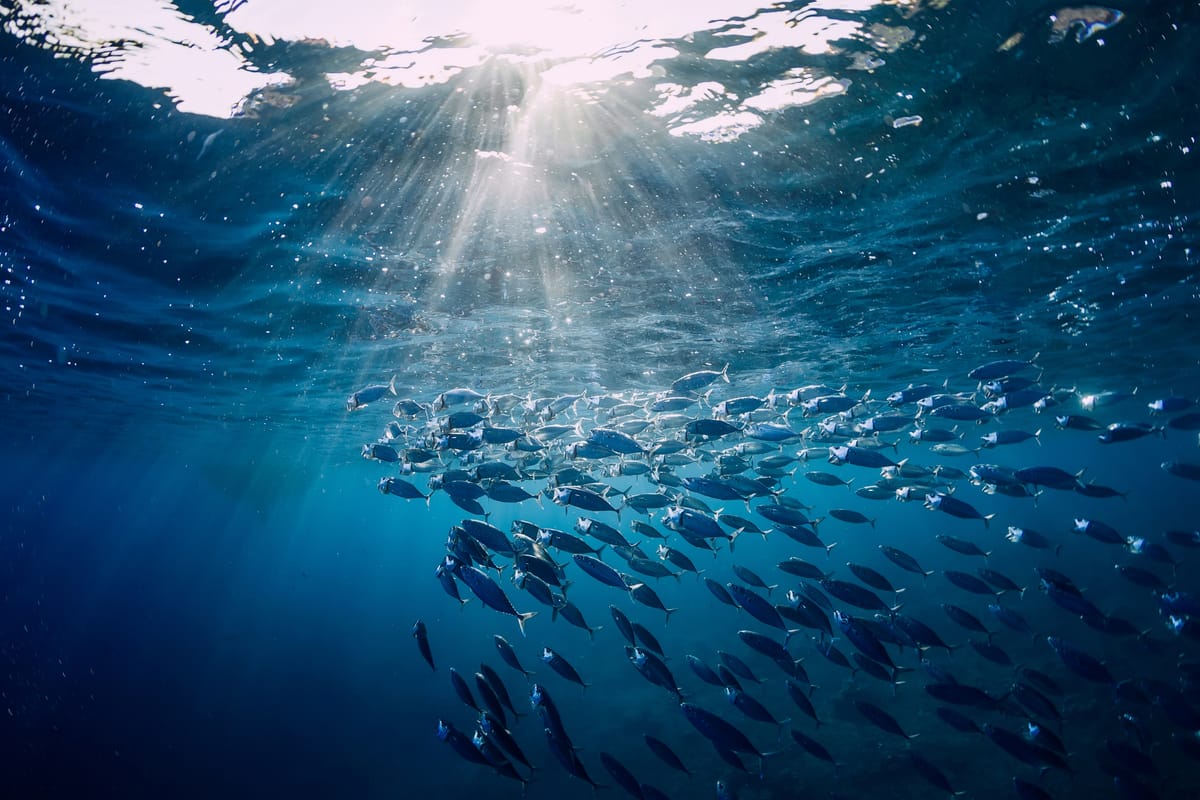This month, as leaders meet for the COP16 biodiversity conference in Colombia, we are turning our attention to the global 30x30 goal—protecting 30% of the world’s ocean and land by 2030. Creating marine protected areas (MPAs) is central to fostering biodiversity, enhancing ocean resilience, and mitigating climate change impacts.
MPAs don’t just preserve ecosystems—they help them bounce back. Studies show that marine conservation efforts increase fish abundance and biomass, with larger, more prolific species producing more offspring, which benefits surrounding fishing areas through “spillover” effects. Protecting marine ecosystems like coral reefs and mangroves also provides invaluable services. Mangroves alone reduce storm and flood damage by an estimated $65 billion per year, and the US Defense Advanced Research Projects Agency (DARPA) is studying ways reef structures could mitigate storm damage.
Despite these benefits, only 2.8% of the ocean is fully or highly protected.
The critical need for protection is clear. Over 90% of global fish stocks are either fully exploited or overfished, leaving marine ecosystems strained. Marine biodiversity is plummeting, with species like sharks and rays declining by over 70% in the past 50 years. Rising sea temperatures and acidification have killed over half of the world’s coral reefs, the foundation of marine life. These alarming trends underscore the urgent need for global action to protect our oceans.

COP16 & 30x30
At the 2022 United Nations Convention on Biological Diversity (COP15), nations committed to protecting 30% of the planet’s land and sea by 2030 under the Kunming-Montreal Global Biodiversity Framework (KMGBF).
COP16, taking place right now in Cali, Colombia, from October 21 - November 1, 2024, will focus on turning these promises into action by addressing crucial issues like resource mobilization and ensuring countries deliver on their commitments through National Biodiversity Strategies and Action Plans (NBSAPs). Questions remain about how the world will fund this commitment, with the current financing gap to protect nature around US$700 billion per year.
One of the summit’s critical challenges is the restructuring of government subsidies, which represent the single largest opportunity to close the funding gap. It has been estimated that reforming harmful subsidies that encourage overfishing and habitat destruction could cover nearly half of the funds needed for nature. Negotiators at COP16 will push for these reforms to direct funding towards sustainable practices.
The Global Biodiversity Framework Fund (GBFF) is a vital component in financing the 30x30 goal. The GBFF aims to help countries achieve biodiversity goals through enhanced management, policy, governance, and finance strategies. With participation ratified by 186 countries, the fund has quickly mobilized resources, making $211 million available for programming to eligible countries. In less than a year since its launch, the GBFF has reviewed and approved four projects already funded, with many more in the pipeline. From funding an $18.5 million project in Mexico to enhance the management of protected areas and support local communities to improving conservation strategies for the Caatinga biome in Brazil, the GBFF is actively mobilizing vital resources to help countries meet their biodiversity targets.
Countries have also made significant strides in marine conservation. In the leadup to COP16, Australia’s Minister of the Environment Tanya Plibersek announced plans to quadruple the Heard Island and McDonald Islands Marine Reserve, positioning Australia to protect 52% of its ocean territory. Similarly, the U.S. has recently designated the Chumash Heritage National Marine Sanctuary, protecting 4,543 square miles of California’s central coast. This sanctuary, the third-largest in the U.S., not only protects rich marine ecosystems but also honors Indigenous stewardship through co-management with local communities.
The Azores, a group of nine islands in the Atlantic Ocean belonging to Portugal, have also followed suit, passing legislation last Friday to create 287,000 square kilometers of marine protected areas—the largest in the North Atlantic. Now, 15% of Azorean waters are fully protected, and another 15% are highly protected.
However, despite recent progress, the rate of MPA creation is still insufficient. A recent study reveals that the world would need approximately 85 new MPAs daily over six years starting in 2025 to achieve the 30x30 goal. COP16 will be pivotal in accelerating the pace of global conservation efforts to meet this ambitious timeline and protect the planet's biodiversity.
The High Seas
Another crucial component to achieving 30x30 is protecting the High Seas, which cover nearly half of Earth’s surface and make up more than 60% of the ocean. These vast areas beyond any nation’s jurisdiction harbor some of the planet’s most important biodiversity and play an indispensable role in regulating the climate. Despite their ecological importance, only around 1.5% of the High Seas are fully protected. This leaves most of these waters vulnerable to activities like industrial fishing, deep-sea mining, and unregulated shipping.
After nearly two decades of negotiations, the finalization of the High Seas Treaty in June 2023 was a groundbreaking achievement for global ocean governance. The Treaty establishes key measures, including the equitable sharing of marine genetic resources (MGRs), area-based management tools (ABMTs) like marine protected areas (MPAs), enhanced knowledge and technology sharing, and more stringent environmental impact assessments (EIAs) to regulate high-impact activities. These tools are vital to curbing destructive practices and ensuring conservation efforts extend beyond national borders.
However, the Treaty can only enter into force once ratified by at least 60 countries, a significant hurdle that remains to be cleared. With only thirteen nations having done so to date, achieving widespread global support is an urgent challenge. The coming months will be critical in building the necessary momentum, with a key goal being to secure full ratification by the 3rd UN Ocean Conference in June 2025.
As COP16 in Colombia kicks off this week and the 30x30 target deadline fast approaches, global leaders must secure ratification and turn these ambitious commitments into meaningful ocean protection.
Member Updates
- Eco-friendly leathers from INVERSA, made from non-native species like lionfish and Silverfin, made a high-profile debut at Paris Fashion Week. On September 30th, Uruguayan American designer Gabriela Hearst showcased INVERSA™ materials in her Spring/Summer 2025 collection. Highlights included footwear and handbags, such as the bestselling Edwina pump in INVERSA™ python—made from invasive pythons that threaten the Greater Everglades ecosystem.
- Rrreefs, a startup focused on restoring degraded coral reefs to regenerate marine life, was named a winner of the Blue Economy Uplink Challenge by the World Economic Forum. The challenge, launched in partnership with Saudi Arabia and WAVE, seeks to highlight solutions to marine pollution, conservation, and rewilding. As a winner, Rrreefs will gain access to exclusive networking opportunities, tailored support, increased visibility, and a share of the CHF 300,000 prize.
- Loliware, a materials innovation company that uses AI to create seaweed-based alternatives to single-use plastics, has appointed Jonathan Plisco as its new Chief Commercial Officer. With over 40 years of experience in the plastics industry, Plisco will spearhead the company’s global commercialization efforts, focusing on strategic growth and industry-wide innovation.
- Cruz Foam, a circular materials company offering packaging foam made from repurposed food waste, received the Tocco Earth’s Plastic-Free Innovation Award at their Future Matters event on September 12th in Paris, France. They also announced some of the exciting work they’re doing with Amazon Robotics to expand the application of sustainable materials in their supply chain. Finally, Cruz Foam was featured in a Harvard Business School Circular article, which highlighted its role in driving the circular economy and its success in making sustainable packaging cost-competitive.


